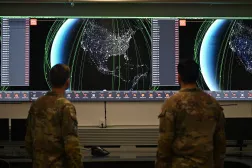DARPA harnesses AI to keep tabs on space weapons, spy satellites on orbit

As the Pentagon continues to sound alarms over the growing number of satellites and debris in space, a new system from the Defense Advanced Research Projects Agency aims to operationalize artificial intelligence to help identify and categorize objects in orbit.
Slingshot Aerospace announced Wednesday that it has partnered with DARPA to create Agatha — an AI-enabled system able to distinguish potentially harmful space vehicles within large satellite constellations. The company recently demonstrated Agatha’s ability to identify multiple “non-nefarious outlier” satellites operating in real-world commercial constellations, according to a Slingshot news release.
First tapped by DARPA for the project in 2023, the company has since trained Agatha on over six decades of simulated constellation data created by the firm. With the program completed as of January, Slingshot is actively engaging with U.S. government agencies and commercial space companies to discuss integrating Agatha into their respective space domain awareness missions.
“As space activity shifts from satellites owned by a small number of operators to massive constellations operated by an array of owners, the need for transparency increases,” Dylan Kesler, director of data science and AI at Slingshot Aerospace, said in a statement. “The ability to quickly identify anomalies — whether a malfunctioning spacecraft or an intentionally nefarious ‘wolf in sheep’s clothing’ — is an increasingly important aspect of maintaining safety and security in space and on Earth.”
To categorize satellites in orbit, Agatha’s AI specifically uses inverse reinforcement learning techniques to evaluate an object’s behavior and identify its intentions. According to Slingshot, the AI automatically takes in space data and works to identify anomalies in real-time without a cue from operators.
Not only does it determine exceptions in maneuvers, but also aims to discern the strategic reasoning for why a satellite may be acting strangely, the company stated.
“Identifying malfunctioning or potentially nefarious objects and their objectives within large satellite constellations is a complex challenge that required us to reach beyond traditional approaches and develop a novel and scalable AI algorithm,” Kesler said. “Our Agatha model has also proven its ability to deliver high-quality insights that provide ‘explainability’ or context for why specific objects were flagged.”
The technology comes as both commercial and government organizations around the world plan to launch large satellites constellations into space — including U.S. adversaries. China plans to launch two mega-constellations that comprise over 20,000 satellites this year, and the Pentagon confirmed that Russia launched what is likely a counterspace weapon to target American systems in low-Earth orbit (LEO) in March.
In response, leaders across the Pentagon have expressed concern over adversaries hiding satellites in these large constellations that can spy on and potentially harm U.S. systems. To help operators in handling the growing number of objects, U.S. Space Command and the Space Force are seeking capabilities that can offer improved situational awareness.
“One of the main things we need in space as we move forward is space domain awareness. We need to be able to characterize the domain, we need to understand what is what, where and also what’s its intent,” Chief Master Sergeant Jacob Simmons, senior enlisted leader at Spacecom, told reporters during a meeting at the annual Space Symposium in April. “Gone are the days that a satellite would just follow the physics, … they maneuver and we have to be able to keep custody and be able to not only track, but understand in the gaps where it might have gone.”
As Slingshot looks to deploy Agatha in real-world operations for space domain awareness, Space Systems Command is separately leveraging AI to help coordinate the multiple sensors on orbit. The acquisition command is currently testing a system known as Machina that assists operators in running space-based sensors used to observe objects in space, according to Col. Bryon McClain, program executive officer for space domain awareness and combat power at SSC.
“Instead of asking a specific sensor to look at a specific object, you type in what your problem set is and the system helps generate what is the best orchestration of sensors to meet that problem set,” McClain said Wednesday during a webinar hosted by C4ISRNet.
While Machina is still considered experimental, McClain said SSC is already rolling it out to some warfighters for real operations. He emphasized that as AI continues to advance, it has potential to assist the Space Force in data processing and completing repetitive tasks.
“We are continuously looking at what opportunities are out there and where we can blend that new technology,” he said.






